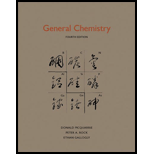
Concept explainers
(a)
Interpretation:
The molality, colligative molality, freezing point, and the boiling point of
Concept Introduction:
Molarity can be defined as the number of moles of solute per liter of solution. Molality can be defined as the number of moles of solute per kilogram of solvent.
Boiling point elevation:
The boiling point of a solution is higher than the boiling point of the pure solvent. The amount by which the boiling point of solution exceeds the boiling point of the pure liquid that is called the boiling point elevation. The mathematical relationship is given below.
Where,
Freezing point depression:
The lowering of the vapor pressure of a solvent by a solute leads to a lowering of the freezing point of the solution relative to that of the pure solvent. This effect is called as the freezing point depression. The mathematical relationship is given below.
Where,
(a)
Explanation of Solution
Given that
The number of moles of
The molality and colligative molality of the solution can be calculated as given below.
The value of
The freezing point of the solution can be calculated as given below.
Therefore, the freezing point of the solution is
The boiling point of the solution can be calculated as given below.
Therefore, the boiling point of the solution is
(b)
Interpretation:
The molality, colligative molality, freezing point, and the boiling point of
Concept Introduction:
Refer to part (a).
(b)
Explanation of Solution
Given that
Ethanol is a weak electrolyte. Therefore, its colligative molality and molality are same.
The number of moles of ethanol can be calculated as shown below.
The molality and colligative molality of the solution can be calculated as given below.
The value of
The freezing point of the solution can be calculated as given below.
Therefore, the freezing point of the solution is
The boiling point of the solution can be calculated as given below.
Therefore, the boiling point of the solution is
Want to see more full solutions like this?
Chapter 16 Solutions
General Chemistry
 ChemistryChemistryISBN:9781305957404Author:Steven S. Zumdahl, Susan A. Zumdahl, Donald J. DeCostePublisher:Cengage Learning
ChemistryChemistryISBN:9781305957404Author:Steven S. Zumdahl, Susan A. Zumdahl, Donald J. DeCostePublisher:Cengage Learning ChemistryChemistryISBN:9781259911156Author:Raymond Chang Dr., Jason Overby ProfessorPublisher:McGraw-Hill Education
ChemistryChemistryISBN:9781259911156Author:Raymond Chang Dr., Jason Overby ProfessorPublisher:McGraw-Hill Education Principles of Instrumental AnalysisChemistryISBN:9781305577213Author:Douglas A. Skoog, F. James Holler, Stanley R. CrouchPublisher:Cengage Learning
Principles of Instrumental AnalysisChemistryISBN:9781305577213Author:Douglas A. Skoog, F. James Holler, Stanley R. CrouchPublisher:Cengage Learning Organic ChemistryChemistryISBN:9780078021558Author:Janice Gorzynski Smith Dr.Publisher:McGraw-Hill Education
Organic ChemistryChemistryISBN:9780078021558Author:Janice Gorzynski Smith Dr.Publisher:McGraw-Hill Education Chemistry: Principles and ReactionsChemistryISBN:9781305079373Author:William L. Masterton, Cecile N. HurleyPublisher:Cengage Learning
Chemistry: Principles and ReactionsChemistryISBN:9781305079373Author:William L. Masterton, Cecile N. HurleyPublisher:Cengage Learning Elementary Principles of Chemical Processes, Bind...ChemistryISBN:9781118431221Author:Richard M. Felder, Ronald W. Rousseau, Lisa G. BullardPublisher:WILEY
Elementary Principles of Chemical Processes, Bind...ChemistryISBN:9781118431221Author:Richard M. Felder, Ronald W. Rousseau, Lisa G. BullardPublisher:WILEY





